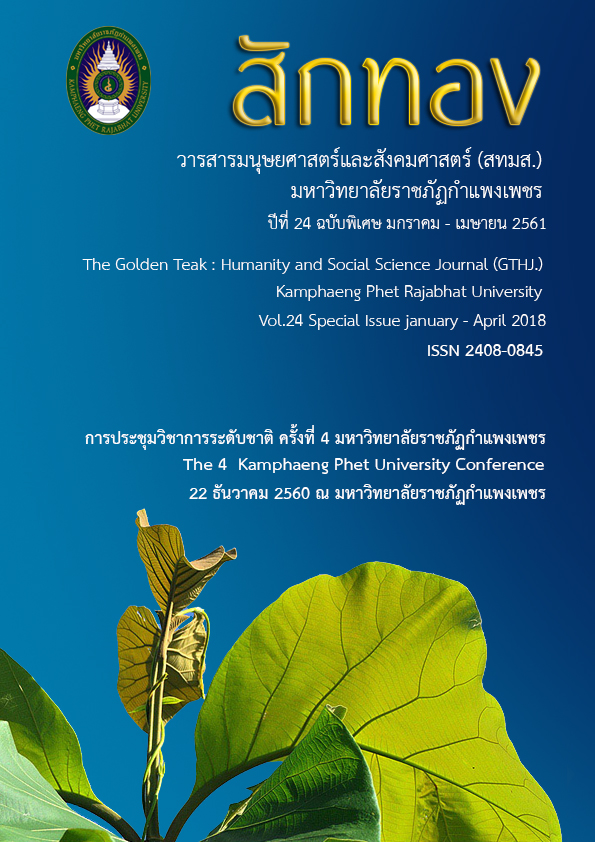Determinants of Chinese Tourists’ Decision-making in Selecting Tourist Attractions in Chiang Mai Province
Main Article Content
Abstract
The objectives of the research were 1. to study the level of perspective on tourism image, facilities, tourism resources, and Chinese tourists’ decision-making, 2. to study the determination of Chinese tourists’ decision-making in selecting tourist attractions in Chiang Mai Province. It was a survey research and involved three hundred and ninety-eight Chinese tourists who visited Chiang Mai. The data obtained from the questionnaire were analyzed with descriptive statistics of percentage, mean, standard deviation, and inferential statistics by Enter multiple regression analysis. The findings revealed that most of Chinese tourists who visited Chiang Mai lived in Guangdong Sheng. They liked the recreational attractions and natural attractions. Most tourists accompanied by friends and took the local minibus service. They stayed around 3-4 nights and spent their 1,001-3,000 Chinese Yuan. The level of Chinese tourists’ perspective focused on tourism image, tourism resources, and facilities respectively. Results of Enter multiple regression analysis indicated that facilities affected to the decision-making the most by having the regression coefficient of 0.304. Tourism resources affected to the decision-making by having the regression coefficient of 0.263, and tourism image affected to the decision-making by having the regression coefficient of 0.224 respectively.
Article Details
บทความที่ได้รับการตีพิมพ์เป็นลิขสิทธิ์ของวารสาร สักทอง : วารสารมนุษยศาสตร์และสังคมศาสตร์ สถาบันวิจัยและพัฒนา มหาวิทยาลับราชภัฏกำแพงเพชร
ข้อคิดเห็นใดๆ ที่ปรากฎในวารสารเป็นวรรณกรรมของผู้เขียนโดยเฉพาะ ซึ่งมหาวิทยาลัยราชภัฏกำแพงเพชรและบรรณาธิการไม่จำเป็นต้องเห็นด้วย
References
Cochran, W. G. (1953). Sampling Techniques. New York : John Wiley & Sons.
Department of Tourism. (2017). Thai Tourism Strategy 2015-2017. [Online]. Available :
www.mots.go.th [2017 January 25].
_______. (2015). Tourist statistics of Chinese. [Online]. Available : https://www.tourism.go.th
[2017 January 25].
Echtner, C.M. & Ritchie, J.R.B. (1993). The Measurement of Destination Image : An Empirical
Assessment. Journal of Travel Research, 31(3), 92-612.
_______. (2003). The meaning and measurement of destination image.
The Journal of Tourism Studies, 14(1), 37-48.
Eisichaikul, R. (2005). Human Resources Management for Tourist industry. Bangkok :
Kasetsart University.
Gursoy, D. & McCleary, K.W. (2003). An integrative model of tourists’ information search
behavior. Annals of Tourism Research, 31, 78-83.
Holloway, C. & Humphreys, C. (2012). The Business of Tourism. (9 th ed.). Education Canada :
Pearson.
Jitangwatana, B. (2012). Marketing Management for Tourism Industry. Bangkok :
Press and Deisign.
Kim, H. & Richardson, S.L. (2003). Motion picture impacts on destination images. Annals of
Tourism Research, 30(1), 216-237.
Leisen, B. (2001). Image segmentation : The case of tourism destination. Journal of Service
Marketing, 5(4), 25-42.
Maneerat, R. (2007). Visitor’s view on facility management and service at Thung
Salaeng Luang National Park. Phitsanulok Province and Phetchabun Province.
Thesis Master of Public Administration Phranakhon Rajabhat University.
Ministry of Tourism and Sports. ( 2016). Data of Tourism. [Online]. Available :
http://www.mots.go.th [2017, April 18].
Nadeau, J. (2008). Destination in a Country Image Context. Annals of Tourism Research,
35(1), 84-132.
Phetsatit, P, Dockthaisong, B. & Homying, W. (2015,May-August). The Strategies of
Sustainable Tourism Management of Kamphaeng Phet Province. The Golden Teak
: Humanity and Social Science, 21(2), 173-186.
Schneider, I. & Sönmez, S. (1999). Exploring the Touristic Image of Jordan. Tourism
Management, 20(4), 539-542.
Tourism Authority of Thailand. (2016). Tourist Industry. [Online]. Available :
https://thai.tourismthailand.org [2017, April 16].
Wongvarnish, W. (2003). Geography of Tourism. Bangkok : Thammasat University.
Wu, K.L. (2006). What do families with children need from a museum. [Online]. Available :
http://culturalpolicyjournal.org/past-issues/issue-no-2/dofamilies-need-a-museum.
[2017, March 12].

